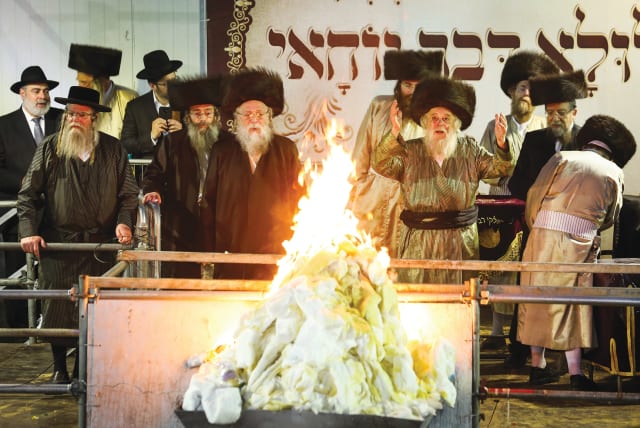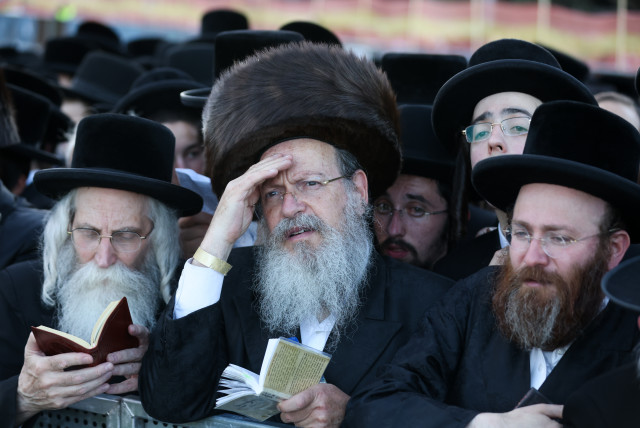Idolatry: The Jewish version

MIDDLE ISRAEL: Regardless of its safety hazards, the Mount Meron jamboree is a pagan perversion of Judaism.
I turn my eyes to the mountains,” wrote the psalmist (121:1), and then asked: “From where will my help come?”Sung by the Levites on the Temple’s stairs, this line encapsulated the gap between the pagan mindset and the Jewish faith.
Mountains have unsettled mankind from the dawn of history. Looking from afar at Mount Olympus, the ancient Greeks believed it was god’s nest. So did the Japanese when they looked at Mount Fuji, and the Chinese in the face of five mountains spread along their east. In the same spirit, biblical Israel’s Aramean neighbors suspected that “their god is a god of the mountains” (I Kings 20:23).
That is not what Israel was told. The prophets believed God is limitless and is thus confined to no location, no matter how lofty, foggy or pristine. However, what the prophets thought was one thing, and where the people went was another. That is why the Bible repeatedly rebuked the Israelites who “set up pillars and sacred posts… on every lofty hill” (II Kings 17:10).
Our forebears, like the surrounding civilizations, included impressionable people who were lured by idolatry’s manipulation of the senses through size, color, fire and death.
Now the idolatry that plagued our forebears is back at play in the Promised Land, as next week’s pilgrimage to Mount Meron will attest.

HOW MANY will arrive at the Galilee’s highest peak for this year’s Lag Ba’omer feast remains to be seen. Last year’s attendance plunged to 130,000, as opposed to more than half a million who flocked to the largest annual event in Israel until the 2021 stampede in which 45 people, mostly ultra-Orthodox pilgrims, were killed.
The Mount Meron Disaster, as it came to be known, convinced thousands to avoid the pilgrimage and made the Bennett government control the crowds’ ascendance to the tomb of Rabbi Shimon Bar-Yochai, the ancient mystic whose commemoration is at the heart of the jamboree on the mountain.
So massive was the convergence on the mountain that it deployed 1,000 buses which brought pilgrims not only from the country’s North, South and Center but also ones who flew especially from abroad, much the way Muslims voyage from afar to touch the Kaaba, and Catholics journey to see the pope.
Just what will happen by the mountain next week is hard to predict. The minister overseeing the event, Meir Porush of United Torah Judaism, sounded so complacent this week that he found time to attack Prime Minister Benjamin Netanyahu on another matter (Likud’s foot-dragging on passing the draft bill).
One can only hope the mountainside happening will end as peacefully as Porush apparently assumes it will. The insurance industry is less confident; so much so that no company was prepared to insure the event that crams a multitude on a thickly forested mountain with poor infrastructure and planning.
Yet beyond public safety looms the religious question: What, actually, is this whole psychosis about, why does it attract such a multitude, and what – if anything – justifies the risks it involves?
The Mount Meron feast is not part of the Jewish faith
THE EMBARRASSING truth is that the Mount Meron feast is not part of the Jewish faith, not to mention Jewish law. Invented by Galilean Kabbalists in the 16th century, this holiday is not mentioned in the Mishna and Talmud.
Rabbinical Judaism’s most iconic luminaries, from Rashi and Maimonides to the Vilna Gaon, never observed it. European Jewry hardly knew of this novelty; and when it did become known, the great ultra-Orthodox leader Rabbi Moshe Sofer (1762-1839) banned its celebration.
Still, the Kabbalists of Safed revered Shimon Bar-Yochai, the sage buried within the mountain opposite their town, a Roman-era scholar who, so they believed, wrote the Zohar, a foundational Kabbalistic work. Historians and philologists think the voluminous work was written more than 1,000 years after his time – but that kind of reality check is often ineffective in the face of the pagan urge.
What exactly the date of Lag Ba’omer has to do with Bar-Yochai’s life is unclear – it may have been the day of his birth, the day of his marriage, or the day he was ordained as a rabbi – but whatever its biographical role, the springtime holiday became a celebration upon a grave.
Now, wrapped in glowing bonfires, cacophonous music and the smell of roasting meat, one can imagine Moses watching this feast and responding the way he did when the sight of the pagan celebration at Mount Sinai’s foothills made him shatter the tablets. Such was, and remains, the collision between his religion of law, rationality and introspection, and paganism’s worship of sensation.
Moses himself chose to be buried in an unknown location, lest his grave spark worship. Jews indeed avoided building mausoleums like those designed to deify many non-Jews, from Lenin and Chiang Kai-shek to Kim Il-sung and Ataturk. The only such structure ever built for a Jewish leader – King Herod – was later destroyed so thoroughly by Jewish believers that it took generations of archaeologists to find its shards.
Yet people, including Jews, want to worship what they can see, hear, smell and feel. That’s why pagans made so much of fire, and that is why fire plays such a central role on Mount Meron, where competing rabbis festively kindle bonfires separately, each for his own blind followers.
The same pagan spirit is what makes so many people replace the Jewish journey to God and His laws with a journey to the bricks above a dead man’s bones, the bricks on which they sprinkle oil and throw candles, seeking this way not the meaning of life but the spirit of death.
Surveying Monday night’s bustle, smoke and fire at Mount Meron, Middle Israelis will recall the psalmist’s search for God beyond the mountains and wonder: If rabbis won’t fight idolatry, who will?
The writer, a Hartman Institute fellow, is the author of the bestselling Mitzad Ha’ivelet Ha’yehudi (The Jewish March of Folly, Yediot Sefarim, 2019), a revisionist history of the Jewish people’s political leadership.
